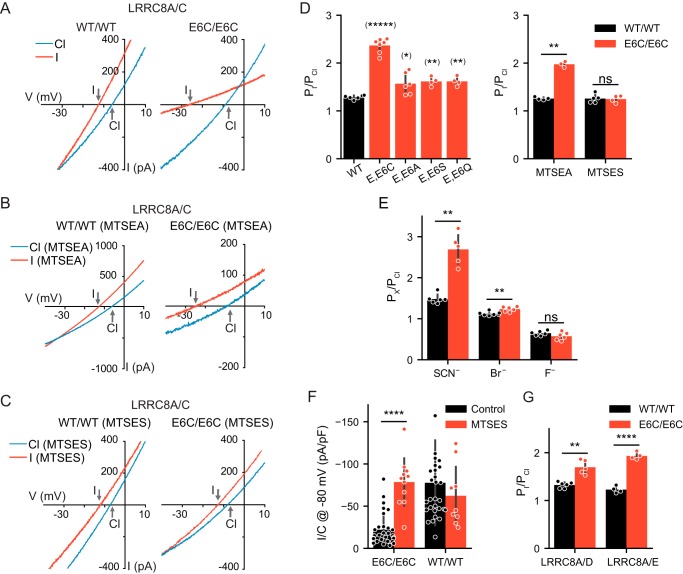Figure 3.
Mutations of Glu-6 alter anion permeability of LRRC8 channels. A–C, typical ICl,vol I/V curves (elicited by voltage ramps from −100 to +100 mV as in Fig. 2B) of WT/WT (left) and E6C/E6C (right) LRRC8A/C heteromers with 110 (blue) or 5 mm Cl− and 105 mm I− (red) extracellular Cl−. Note the large increase in iodide permeability in E6C/E6C mutants (A) that is not abolished by MTSEA (B) but is abolished by intracellular MTSES (1 mm) (C). D, PI/PCl obtained from shifts in reversal potentials for WT/WT and E6C/E6C, E6A/E6A, E6S/E6S, and E6Q/E6Q LRRC8A/C channels (left). Intracellular MTSES (1 mm) restored WT permeability ratio (right). E, mean permeability ratios (PX/PCl) for SCN−, Br−, and F− for WT/WT and E6C/E6C LRRC8A/C channels. F, restoration to WT levels of ICl,vol densities of E6C/E6C LRRC8A/C channels by intracellular MTSES (left), which lacked an effect on WT/WT channels (right) (control measurements as in Figs. 1F (WT) and 2A (E6C)). G, PI/PCl of WT/WT and E6C/E6C in LRRC8A/D and LRRC8A/E heteromers. Error bars, S.D.; *, p < 0.05; **, p < 0.01; ****, p < 0.0001; *****, p < 0.00001; ns, not significant (in D, E, and G, unequal-variance t test for pairwise comparisons; in F, Mann–Whitney test; false-discovery rate controlled by Benjamini–Hochberg procedure). pF, picofarad.

